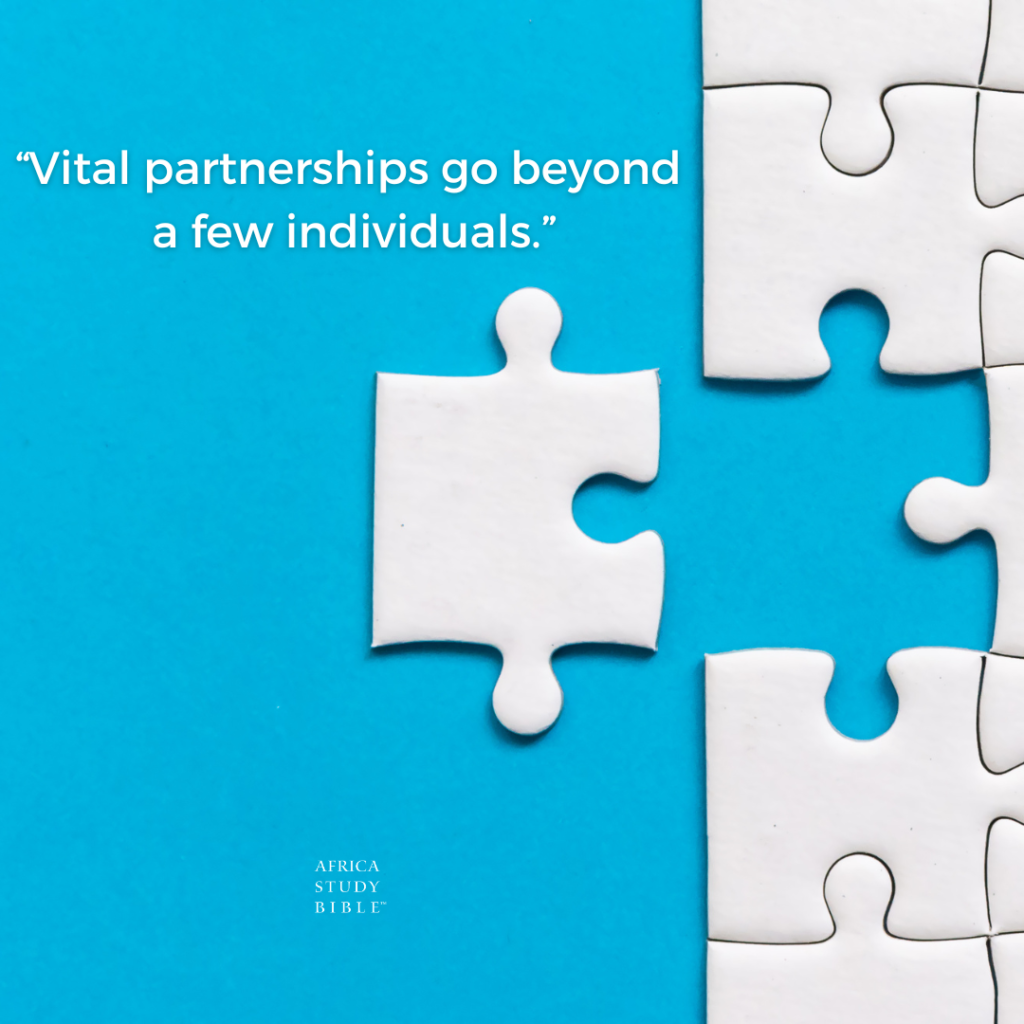Building Vital Partnerships
The Africa Study Bible Experience
By John Jusu, Supervising Editor of Africa Study Bible
Introduction
It started in a coffee shop somewhere in Wheaton. Across the table sat two gentlemen whom we later learnt were father and son. After the pleasantries, the younger gentleman, in a typical American style, said, “Let’s get to the point.” Fine, we said. “What about a study Bible for Africa?” He asked. “Not again!” I quietly said to myself – “another American project for Africa”. He patiently waited for an answer, and I responded: “That would be a great idea, it’s long overdue, but what would it look like.” He looked me in the eyes and said “I don’t know, you tell me. What would a study Bible for Africa look like?”

Partnerships are initiated in several ways. There are policy-driven partnerships where an individual envisions a project, delineates
it, and chooses the right partnership approach for the solution. Such an individual brings to the table an-already thought of project and expects others to join in. There are also incentive-driven partnerships in which monetary incentives are offered for others to join in an already established partnership framework. Often the motivation to join such projects is extrinsic. It is possible that other partners may not be interested in the ethos of the project but the monetary incentives that come with it. These top-down types of partnership are very common in Africa. Often, in such partnerships, the vision and ideas of the implementing partner may be different from the proposing partner. This creates a recipe for partnership failure.
There are also bottom-up strategies in partnership development in which those stakeholder beneficiaries provide a critical voice in the ideation, formation, propagation, and evaluation of the partnership. Such partnerships are driven by mutual interests, faith, and intrinsic
motivation. The ASB used the bottom-up approach in partnership development in
view of the following.
Engaging with Relevant Actors
Vital partnerships go beyond a few individuals. Though partnership projects are often conceived by a few people representing the potential partners, it requires the involvement and input of the community of benefit including parties that are either part of the problem to be addressed or are part of the solution. For example, after the initial ideation of the ASB project, several consultations ensued that brought together significant stakeholders around one table. The stakeholders involved African and international biblical, theological and missiological scholars, would-be funding agencies, educators, and diverse ministry practitioners to operationalize the idea of the ASB. The partnership was locally driven which fostered the need among foremost, the Africans, for better co-operation and coordination, and then with the non-African partners for a broader engagement. Engaging with relevant actors in the partnerships provides a context where the hard conversations involving ownership, funding, sourcing and sources of funding and accountability are made to mutual satisfaction. It is during those conversations that by the grace of God the various partners became aware of each other’s strength and weaknesses and how to build support structures for all involved.

A critical actor in Christian partnerships is the
Holy Spirit. The critical factor that drives successful Christian partnerships
is the realization that the partnership transcends the parties involved. The
partnership is foremost with the Holy Spirit, as the initiator, propagator, and
sustainer of the partnership. Partnerships that transcend parties should never
be about the parties concerned but about the mission of God for which the Holy
Spirit initiated the partnership. With this realization, each party serves the
other as Christian brothers and sisters committed to the same goal and mission.
A partnership that transcends the parties fosters a good foundation and a
rallying point for a better partnership relationship.
Ownership
Stakeholder and beneficiary involvement at the
initial stages of partnership development will foster ownership of the project.
When there is ownership, one partner may not see themselves working for the
other party, but each carries their responsibilities as they support others. The
way partners approach relationships, goals and overall work ethics may depend
on their views about ownership in a partnership agreement. The feeling that
they are contributing to some venture that is critical to the life of the Church
and in line with their personal ministry responsibilities may build resilience
and hope in the task and partnership. They may develop the feeling that it is
their responsibility to contribute meaningfully to the project without
coercion. Ownership provides a high degree of identification with the
partnership. It enhances the easy building of consensus over strategy and
accountability. When there is ownership, hard conversations can ensue around
funding, sourcing, and sources of funding without prejudice and acrimony that
can destroy partnerships. Each partner becomes an ambassador of the project.
Accountability and Transparency
Accountability is always a thorny issue in
partnerships. The idea that Christian partnerships transcend the human elements
involved impresses that we are first accountable to God and then to each
other. That each of us will give an
account of our stewardship to God makes us responsible handlers of the various
resources God has given to us for the partnership task. This necessitates
openness in funds acquisition and disbursement, it enhances honesty in
reporting paid-for time, meeting deadlines and ensures quality work. A Holy
Spirit-driven-partnership ensures mutual accountability and transparency. While
accountability was first required to the Holy Spirit, partnerships must devise
ways in which they are accountable to one another. During the ASB partnerships,
mutually agreed upon tasks and responsibilities were delineated to the point
that each partner knew their roles and trusted others to do their roles as well,
they were made to share priority areas in those roles, a technologically
mediated system was made to track those roles and periodic reporting of
progress or lack thereof were required through robust communication channels.
Such level of accountability created the ethical framework for each partner to
accomplish their responsibilities with integrity and enthusiasm.
Equality/Equity
Holy-Spirit driven partnerships are built on
equality that requires mutual respect between the members of the partnership
irrespective of size and financial strength. Equality in Holy Spirit driven
partnership is anchored on the “body of Christ” ecclesiology that we are all
part of one body and each body must be recognized and respected for the tasks
they perform. In the ASB story, the relationships were not built on
paternalistic hierarchy nor did any one partner condescend on another. Roles
were divided according to competences and abilities, not hierarchy. There was
respect of each other’s mandates, obligations and often the independence to
act. In the partnership, cultural diversity was honored, strengths were
affirmed, and individuals were treated with dignity. Within this ecclesiology,
there was room for constructive dissent that fostered the mission of the
partnership. Recognition of each partner’s worth was demonstrated in times of incorporating
new partners and hiring additional personnel.
Conclusion
The task of the Church as it pursues the mission
of God cannot be carried out by any one individual. It requires partnership
arrangements that are God honoring. Such partnership should be implemented in ways
that honor the views of all, celebrate diversity, uphold commitments, and
empower all to give their best in serving the partnership as a response to
God’s love and obedience to his mandate.
The Africa Study Bible is the most ethnically diverse single-volume biblical resource ever created. It's an all-in-one course in biblical content, theology, history, and culture. Learn more here.
Across the world – and particularly across Africa – millions of people, just like the believers in Pastor Mark's church, have given their lives to Jesus but do not have access to a Bible. We are committed to changing this by providing resources like the Africa Study Bible. Join us in giving Bibles here.
Share on Social Media
Share on Facebook
Share on Twitter
Share on LinkedIn